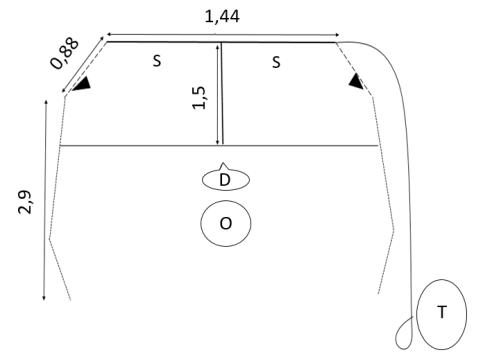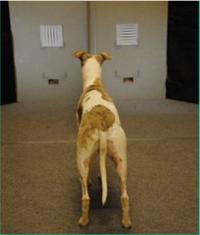Method
Experimental set-up

The dogs were tested with a two-choice discrimination test, where the dog was forced to make a choice between two stimuli at a distance of 1.5 m. The stimuli were printed paper (20x20 cm) with evenly spaced black and white sine-wave gratings.
When starting data collection in the experimental set-up the dogs were given a “non-error” choice i.e. only the correct stimulus was presented either to the right or left side, so that no error could be made. When the dogs had habituated to the set-up they were given choices with both horizontally and vertically oriented stimuli patterns. Training sessions were performed according to predetermined schemes of 20 trials with pseudorandom preset correct choice on either left or right side. All dogs were trained to associate horizontally oriented lines with a reward (frolic). The owner told the dog to make a choice by the command “choose”. When doing this the owner was instructed, beforehand, not to acknowledge the stimuli and look down, to not influence the dog. The dog was noted to have made a choice when it crossed the line (1.5 m in front of the stimuli) with at least one paw. When the dog chose the correct stimulus it was rewarded with a treat (Frolic) released from a hatch. The hatch was opened by the test leader by pulling a connecting rope. When the dog chose the wrong stimulus the owner ignored the choice and continued with the next trial. After approximately half the trials the dog was given a short break. The number and the length of the break depended on the dog’s motivation, which was discussed with the owner.
Two LED spotlights were directed at the stimuli holdings. LEDs of 4000K were chosen to achieve the best resemblance of daylight. In daylight the intensity was set to 43 cd/m2, while in dim light the intensity was 0.0087 cd/m2. The dim light intensity was achieved by adding neutral density filters in front of the spotlights and covering any additional light source near the testing arena.
Animals

This study included dogs of one brachycephalic breed and one dolichocephalic breed. The brachycephalic breed was represented by the pug (N=3) and the whippet (N=4) represented the dolichocephalic breed. All dogs were recruited through social media or personal contacts and were all privately owned.
Visual acuity

Visual acuity was measured by cycles per degree (cpd), which is the number of cycles that fits in 1°. The distance between lines was shortened to achieve higher cpd. Stimuli of every second cpd (2-30 cpd) were used in tests and how fine gratings that was used depended on the performance of the dog.
Responsible for this page:
Director of undergraduate studies Biology
Last updated:
05/03/16
